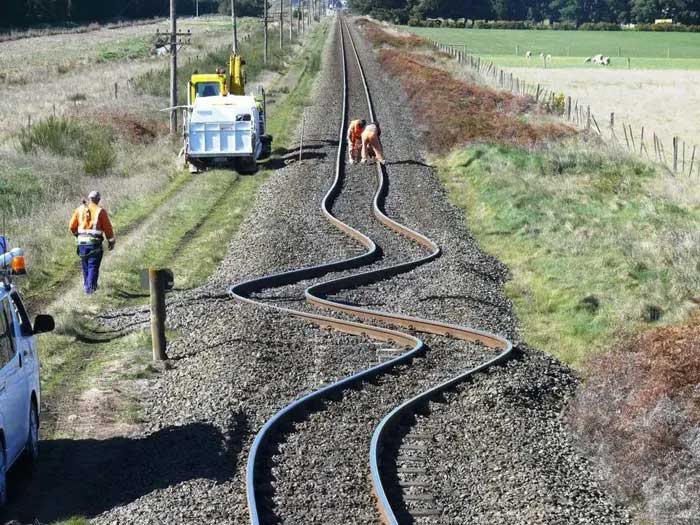Extreme temperatures have posed challenges to infrastructure and caused disruptions on the railways of the UK. Some trains have been canceled, while others have slowed down due to fears that the tracks may warp.
Airport runways and several roads have also shown issues due to the severe weather.
“Much of our infrastructure was not built to withstand temperatures like these,” said UK Transport Secretary Grant Shapps.
Track Deformation
Steel rails expand and tend to warp when temperatures change in any climate.
According to Network Rail, the UK’s rail operating and development agency, rail networks worldwide are designed to function within a temperature range of 45 degrees Celsius, depending on local climate conditions. For example, Spain’s rail network is designed to operate normally between 0-45 degrees Celsius, while in Saudi Arabia, the range is 10-55 degrees Celsius.
In temperate regions like the UK, railways are typically designed to ensure operation within a normal temperature range of -10 to 30 degrees Celsius. The sleepers and the layer of ballast beneath the tracks play a crucial role in stabilizing the rails during both winter and summer.
However, as the UK recorded its hottest day ever, with temperatures exceeding 40 degrees Celsius, the actual temperature at the tracks could reach 60 degrees Celsius, causing the steel rails to expand and bend.

The actual temperature at the tracks can reach 60 degrees Celsius, causing the steel rails to bend.
A train moving quickly on the tracks can accelerate this process through heat generated by friction. Therefore, in extreme heat, trains may face a higher risk due to the phenomenon of warped steel tracks.
In light of this, speed limits have been imposed to protect the rail lines. On some railways, speed limits have even been reduced by half.
Overhead power lines on electrified railways also expand and sag in hot weather or contract in cold weather. Engineers have sought solutions using pulley systems to mitigate the effects of this phenomenon. However, ultimately, the power lines will still sag if the weather is too hot, putting them at risk of tangling with the pantographs on top of the trains.
Melting Asphalt
National Highways, a government-owned company responsible for operating and maintaining roads in the UK, stated that highways and major routes are built with improved asphalt surfaces.
Theoretically, these surfaces are less likely to melt and can withstand temperatures inside reaching 60 degrees Celsius or outside air temperatures of 40 degrees Celsius.
However, most of the basic asphalt laid on local roads can start to melt at temperatures of 50 degrees Celsius.
“The road surface becomes slippery and sinks, making it very difficult for vehicles to brake,” said Professor Xiangming Zhou, head of the civil and environmental engineering department at Brunel University (UK).
“Stone mastic asphalt is cheaper and less abrasive on tires than some other materials, but because it is black, it tends to heat up faster in sunlight,” Professor Zhou added.
This is why UK authorities have requested specialized vehicles, typically used in freezing weather, to be on standby to spread sand and dirt on the asphalt surface.
About 4% of roads in the UK are made of concrete. Many countries use concrete to build highways because this material is more durable than asphalt. Nevertheless, they are not immune to issues in extreme temperature conditions, and the closure of the A14 road is a prime example.
The two-lane road near Cambridge, which has an asphalt surface laid over old concrete slabs, experienced high temperatures causing the old concrete slabs to expand and warp, creating bumps that forced the operator to close and urgently repair it overnight.
Rick Green, president of the Asphalt Industry Alliance, stated that building a road that can withstand all temperatures is “a challenge for design engineers.” At extremely high temperatures, the surface “does not melt, but the bitumen within it can soften,” which increases the risk of deformation.
Damaged Runways
Luton Airport, north of London, also faced asphalt issues as temperatures soared. The airport had to temporarily suspend operations on the afternoon of July 18 after the heat caused “defects” on the runway, forcing flights to be diverted.
According to the airport, “high surface temperatures caused a small section (of the runway) to buckle,” and engineers repaired it within a few hours, but it still caused significant disruptions for passengers.
While local roads often have shade from surrounding trees and buildings, runways are exposed directly to sunlight and endure additional thermal pressure from landing and taking off aircraft. Regular repairs and maintenance occur.
Heathrow Airport, which was even hotter than Luton, also experienced runway issues the previous week.
Sky News reported on July 18 that the hot weather also caused asphalt to melt on the Brize Norton Air Force Base in Oxfordshire, southeastern England. The news agency cited a military source stating that the Royal Air Force had temporarily suspended flights in and out of the base.
What Are the Solutions?
Network Rail has spent hundreds of millions of pounds each year to mitigate the impacts of climate change. However, most of the funds are used to combat erosion or damage from storms.
Future infrastructure may be designed to withstand a warmer climate, but it could then be more susceptible to damage and cracking in freezing winter weather when the tracks contract. Some rail materials, such as concrete sleepers, are designed to endure a wider range of temperatures but will be significantly more expensive.
In the face of extreme weather, countries will also need to monitor and adapt, which will certainly be time-consuming and costly. Projects to upgrade roads for better resilience to heat will become an economic and political challenge.




















































